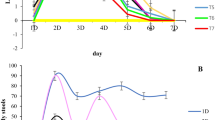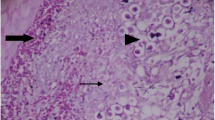Abstract
Broiler chicks were orally dosed with a hot-water extract of mycelia from Cordyceps sinensis (CS-HW) to assess possible substitution of Avilamycin as an antibiotic growth promoter (AGP). The growth performance (body weight gain and survivability) and the health index (the microflora in the small intestines and the antibody titer to Newcastle disease virus) of chicks were significantly improved in the CS-HW (600 mg/kg diet) and the Avilamycin (20 mg/kg diet) fed group in comparison with the control group (p<0.05). The Avilamycin-fed group and the CS-HW-fed group had similar growth performances but the latter gave a better microbial flora in the small intestines. These results indicate that CS-HW enhances the physiological activity in chicks and can be used as a substitute for AGPs.
Similar content being viewed by others
References
Barrow PA (1992) Probiotics for chickens. In: Fuller R, ed. Probiotics, The Scientific Basis. London: Chapman and Hall, pp. 225–257.
Butaye P, van Damme K, Devriese LA, van Damme L, Baele M, Lauwers S, Haesebrouck F (2000) In vitro susceptibility of Enterococcus faecium isolated from food to growth-promoting and therapeutic antibiotics. Int. J. Food Microbiol. 54: 181–187.
Caja G, Garin D, Mesia J (2000) Stimulating rumen function; organic acid salts as growth promoters. Feed Int. 21: 23–25.
Chok PW, Choon SP, Benjamin HSL (1993) A rapid and simple microfluorometric phagocytosis assay. J. Immunol. Meth. 162: 1–7.
Fujiwaru S, Hashiba H, Hirota T, Forstner JF (2001) Inhibition of the binding of enterotoxigenic Escherichia coli Pb 176 to human intestinal epithecial cell line HCT-8 by an extracellular protein fraction containing BIF of Bifidobacterium longum SBT2928: suggestive evidence of blocking of the binding receptor gangliotetraosylceramide on the cell surface. Int. J. Food Microb. 67: 97–106.
Halpern GM (1999) Cordyceps China's Healing Mushroom. New York, NY: Avery Publishing Group.
James SP, Zeitz M (1994) Human gastrointestinal mucosal T cells. In: Pearay LO, Jiri M, Michael EL, Warren S, Jerry RM, John B, eds. Handbook of Mucosal Immunology. London: Academic Press, pp. 275–285.
JETACAR (1999) Antibiotic-resistant bacteria in animals and humans. In: The Use of Antibiotics in Food-Producing Animals. North Adelaide: Commonwealth Department of Agriculture, Fisheries and Forestry, pp. 1–6.
Kame C (2000) A novel look at a classic approach of plant extracts. Feed Mix 8: 19–21.
Kato T, Owen RL (1994) Structure and function of intestinal mucosal epithelium. In: Ogra PL, Mestecky J, Lamm ME, Strober W, McGhee JR, Bienenstock J, eds. Handbook of Mucosal Immunology. San Diego: Academic Press, pp. 11–26.
KFIC (1985) Nutritional Requirement and Breeding System for Domestic Aanimals in Korea. Seoul: Dongsin Press.
Kim KI (2001) Studies on immunological properties of polysaccharide isolated from Curcuma zedoaria Roscoe. Ph.D Thesis. Seoul, Korea: Korea University.
Koh JH, Yu KW, Suh HJ, Ahn TS (2001) Pharmacological activities of the mycelial extract of cultured Cordyceps sinensis. Agric. Chem. Biotechnol. 44: 77–83.
Koh JH, Yu KW, Suh HJ, Cho YM, Ahn TS (2002) Activation of macrophage and intestinal immune system by orally administered decoction from cultured mycelium of Cordyceps sinensis. Biosci. Biotechnol. Biochem. 66: 407–411.
Kwon NH, Kim SH, Bae WK, Kim JK, Lim JY (2001) Antimicrobial activity of Lactobacillus reuteri against major food-borne pathogens. J. Food Hyg. Safety 16: 264–273.
Peter S (2000) Yeast's secret weapon aids animal production. Feed Mix 8: 32–34.
Schwarz S, Kehrenberg C, Walsh TR (2001) Use of antimicrobial agent in veterinary medicine and food animal production. Int. J. Antimicrob. Ag. 17: 431–437.
Watkins KL, Shryock TR, Dearth RN, Saif YM (1997) In-vitro antimicrobial susceptibility of Clostridium perfringens from commercial turkey and broiler chicken origin. Vet. Microbiol. 54: 195–200.
Author information
Authors and Affiliations
Corresponding author
Rights and permissions
About this article
Cite this article
Koh, J.H., Suh, H.J. & Ahn, T.S. Hot-water extract from mycelia of Cordyceps sinensis as a substitute for antibiotic growth promoters. Biotechnology Letters 25, 585–590 (2003). https://doi.org/10.1023/A:1022893000418
Issue Date:
DOI: https://doi.org/10.1023/A:1022893000418




